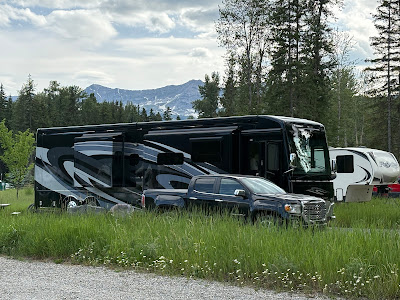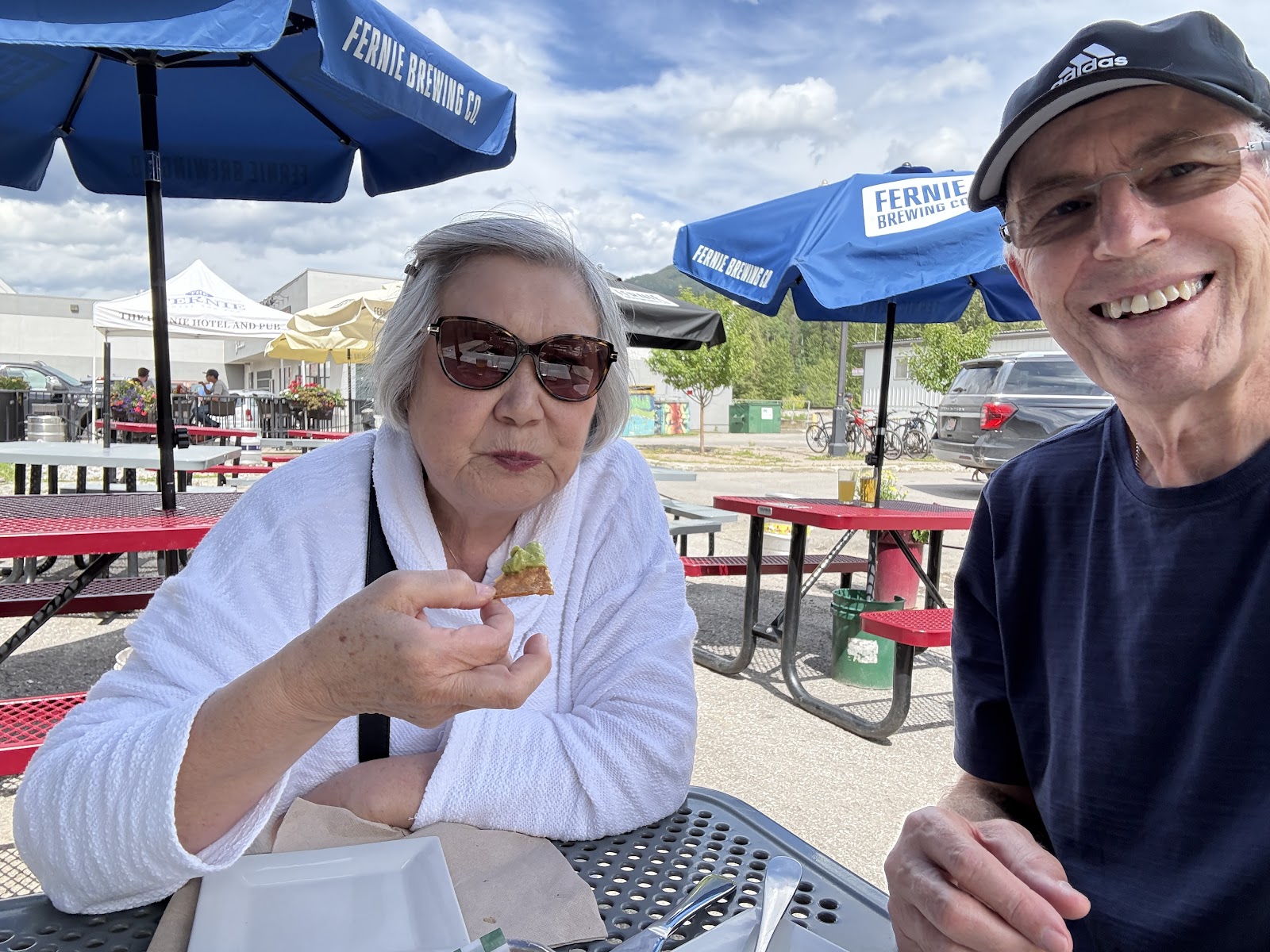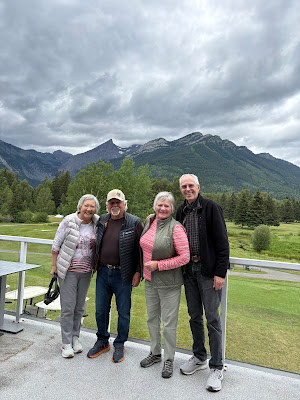Our campground near Swift Current was convenient, though fairly basic. It required a two-kilometre drive up a rugged gravel road and we arrived in cold, wet weather. We quickly set up and turned on both the electric heater and propane furnace to warm the trailer. Overnight, strong winds and steady rain made a mess of that gravel road.
The next morning, at our first charging station, we were treated to the sight of our car and trailer caked in a thick mud-and-gravel mix, dried to something close to concrete. In some spots it was nearly two inches thick, and the weight of it actually damaged one of the car’s mud flaps. When we reached our next campground in Taber, Alberta, it took about 40 minutes with a high-pressure hose to remove the worst of the mess.
As we crossed the prairies, oil pumpjacks became a familiar sight in the farmers’ fields, as did the massive crop irrigation rigs that stretch across them. These rigs, fed by aquifers and rivers, have transformed farming in the region. Bright yellow fields of canola provided a striking contrast to other crops across the vast, open landscape.
Oil Pumpjacks inhabit many farmer's fields
Beautiful yellow canola crop
Huge grain elevator and long line of grain rail cars (on left) waiting to be loaded
Our 4th province this trip
Some quick facts about Alberta:
Alberta is Canada’s fourth-largest province—over 1.5 times the size of California.
Known as Canada’s “Energy Province,” it holds the third-largest proven oil reserves in the world and has vast natural gas reserves.
It boasts six UNESCO World Heritage Sites—more than any other province—including places with evocative names like Head-Smashed-In Buffalo Jump, Dinosaur Provincial Park, and Wood Buffalo National Park.
Alberta is also an agricultural powerhouse, producing wheat, canola, barley, and more.
Its diverse landscape includes prairies, badlands, foothills, and the stunning Rocky Mountains.
The province is world-renowned for its wealth of dinosaur fossils, especially in the Badlands and Dinosaur Provincial Park.
We spent two nights at Taber Municipal Campground and were thoroughly charmed. Originally part of a farm donated to the town in the 1930s, it sits on a floodplain and has served as a campground and public park for 91 years. With a generous tree canopy providing shade over spacious campsites, it felt like a hidden gem. Our site backed onto a river, and deer wandered through regularly. To our surprise—and delight—there were no mosquitoes, making evening happy hours outside all the more enjoyable.
The Oldman River running behind our campsite in Taber Municipal Campground, Alberta
Lovely tree canopy and our trailer in the background
Deer frequently visit our campsite
Some busy beavers.....
Dinner in the air fryer - cooking outside keeps the trailer cooler
Our next destination was Fernie, BC. We were a bit anxious about energy consumption climbing through the foothills, especially with forecasted headwinds of 15 to 25 km/h. But by keeping our speed modest on the 261-kilometre drive, we made two cautious charging stops—though in the end, one would have sufficed.
The Rocky Mountains come in to view as we drive west on the Crowsnest Highway #3
More wind generators in the foothills
We are now entering the majestic Rocky Mountains
One of the most dramatic stories of this region comes from the town of Frank, founded in 1901 at the base of Turtle Mountain. The Canadian Pacific Railway built a spur line to haul coal from the area, and by 1903 the town had over 600 residents. Turtle Mountain, composed of unstable layers of limestone over softer shale and sandstone, was known by local Indigenous peoples as "the mountain that moves."
On April 29, 1903, at 4:10 a.m., 30 million cubic metres of limestone—110 million tonnes—broke loose from the mountain. For only 100 seconds, the slide, 3,300 metres wide, 425 metres high, and 150 metres deep, roared across the valley at approximately 112 km/h. The sound was heard more than 200 kilometres away. Approximately 90 people died, making it the deadliest landslide in Canadian history. Most victims remain buried beneath the rubble; only 12 bodies were recovered. Incredibly, within three weeks the railway and coal mine were operating again, and the town was eventually relocated to a safer location.
Site of Frank Rock Slide (from a distance)
Rock slide swept right across the valley burying part of the town
Brief pull off stop on Crowsnest Highway
Welcome to British Columbia
Wall mural in Sparwood, BC
dedicated to the coal mine workers
Parallel parked in Sparwood BC - only took 2 and a bit parking spaces....
Our stay at Fernie RV Resort was exceptional. Originally named Coal Creek, Fernie was founded in 1887 as a coal mining town and later renamed after William Fernie, a pivotal figure in the region’s coal industry. With the arrival of the railway, the town prospered and earned the nickname "Pittsburgh of the West"—until devastating fires in 1904 and 1908 nearly wiped it out. Rebuilt each time, Fernie has since evolved into a vibrant, year-round outdoor recreation hub.
The RV resort sits beside the Elk River and offers stunning mountain vistas in every direction. Spacious sites, spotless new washrooms and showers, and even a dog-wash station made for a top-notch experience. One evening, just before bed, a deer wandered between our trailer and picnic table. From inside, we could see mountains out of every window. Spectacular.
Our campsite in Fernie RV Resort
Mountains all around us
Mountains outside our bedroom window
Camping takes many forms—from tents to tent trailers, fifth wheels, motorhomes, and the most luxurious bus-sized rigs towing full-sized SUVs. The further west we travelled, the bigger the RVs got. We still feel like beginners, maneuvering carefully and slowly, while seasoned RVers seem to handle their massive setups like compact cars. We’ll get there…
Six pics of some of the different camping rigs around us
The next day, we headed to Fernie Alpine Ski Resort and rode the chairlift up the mountain to take in the sweeping views. Though world-famous for winter sports, in summer the resort transforms into a mountain biking paradise. Riders of all ages brought their bikes up the lift and tore down the rugged trails with gusto—then repeated, all day long. With their fat tires, disc brakes, and shock absorbers, the bikes are engineering marvels. Everyone wore proper helmets and many had body armor for safety. It was a joy to watch the action while soaking up the scenery.
Fernie Alpine Ski Resort
Overdressed - we saw snow up there and thought it would be cold
Mountain bikes on the chairlift
Town of Fernie way down below
Afterwards, we strolled through historic downtown Fernie and capped off the day with a snack and refreshments at a local bar—tired, happy, and already planning our next adventure.
Snack and refreshments at the Fernie Brewing Company
Our last day in Fernie was cool and blustery, with intermittent rain and thick clouds rolling over the peaks. I took the opportunity to catch up on some condo work while Fran filled the trailer with the comforting aroma of freshly baked blueberry coffee cake. In the afternoon, we had the most delightful meetup with locals Annamarie and Hans—friends of our North Channel boating companions, Alan and Margot, who kindly connected us. We shared drinks and a few hours of lively conversation at the Fernie Golf and Country Club, a perfect blend of local charm and hospitality. It was a wonderful way to wrap up our time in Fernie.
Fernie Golf and Country Club with Annamarie and Hans
A walk along the Elk River between showers
Onwards and upwards—mountain talk, of course...



















































